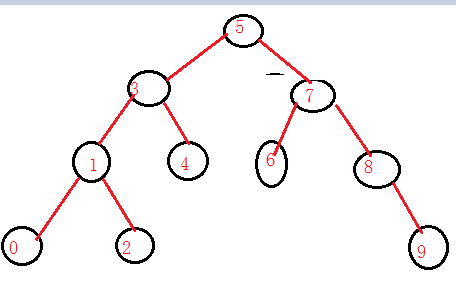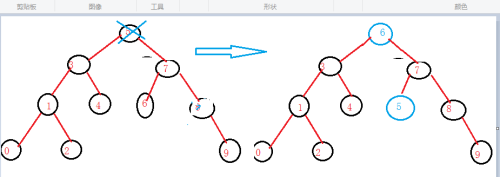二叉搜索樹
二叉搜索樹又被稱爲二叉查找樹、二叉排序樹。其具備以下性質:
1> 每一個節點都有一個作爲搜索依據的關鍵碼(key),並且互不相同
2>左節點的關鍵碼都小於根結點的關鍵碼
3>右節點的關鍵碼都大於根結點的關鍵碼
4>每個子樹都滿足二叉搜索樹
具備以上性質,所以二叉搜索樹的中序遍歷是有序的。
2.二叉搜索樹的構造
每個節點有一個key值和value值,key值是用來區分節點的,每個節點的key值都不相同。每個節點都
有指向左和右的指針。
template<class K, class V>
struct BSTreeNode
{
BSTreeNode(const K&key, const V&value)
:_left(NULL)
, _right(NULL)
, _key(key)
, _value(value)
{}
BSTreeNode<K, V>* _left;
BSTreeNode<K, V>* _right;
K _key;
V _value;
};
template<class K, class V>
class BSTree
{
typedef BSTreeNode<K, V> Node;
public:
BSTree()
:_root(NULL)
{}
~BSTree()
{
if (_root)
{
clear();
}
}
protected:
Node* _root;
};3.二叉搜索樹的插入
如果插入的時候是一顆空樹,則new一個根結點出來,之後插入的時候根據key值來進行判斷插入的位
置,每插入一個值都要從根節點開始判斷,要插入的key值比根結點的key值小,則走左樹,比根節點的
key值大,則走右樹。直到找到正確的位置進行插入,返回true。當然與根節點的值相等的話返回false。
1>非遞歸的插入
bool insert(const K& key, const V&value)
{//遵循左小於根右大於根,每個子樹都滿足
if (_root == NULL)
{
_root = new Node(key, value);
return true;
}
Node*parent = NULL;
Node*cur = _root;
while (cur)
{
if (cur->_key < key)
{
parent = cur;
cur = cur->_right;
}
else if (cur->_key>key)
{
parent = cur;
cur = cur->_left;
}
else
{
return false;
}
}
if (parent->_key > key)
{
parent->_left = new Node(key, value);
}
else
parent->_right = new Node(key, value);
return true;
}
2>遞歸插入
//進行遞歸插入,注意_insertR接收的root參數是引用類型的,
bool insertR(const K&key, const V&value)
{
return _insertR(_root, key, value);
}
protected:
bool _insertR(Node* &root, const K&key, const V&value)
{
if (root == NULL)//此時的root肯定是要插入的key值正確的位置,因爲root是引用的
{
root = new Node(key, value);
return true;
}
if (root->_key > key)
{
_insertR(root->_left, key, value);
}
else if (root->_key < key)
{
_insertR(root->_right, key, value);
}
else
{
return false;
}
}
4.二叉搜索樹的查找
二叉樹最壞的查找情況時間複雜度爲O(n);平均時間複雜度爲O(log2(n))。
Node* find(const K&key)//找到的話返回該節點
{
assert(_root);
Node* cur = _root;
while (cur)
{
if (cur->_key > key)
{
cur = cur->_left;
}
else if (cur->_key < key)
{
cur = cur->_right;
}
else
{
return cur;
}
}
return NULL;
}
5.二叉搜索樹的刪除
二叉搜索樹的刪除可分爲三種情況:
1>要刪除的節點的左樹爲空,右樹可爲空可不爲空,這個節點可能爲根節點,也可能爲其他節點。
刪一個普通的左樹爲空的節點。讓該節點的父親節點指向該節點的右節點,刪除該節點。
刪除這個樹的8這個節點
2>要刪除的節點的右樹爲空,左樹可爲空可不爲空,這個節點可能爲根節點,也可能爲其他節點。
刪除的方法與右節點同理。這裏不舉例子了。
3>要刪除的節點左右都不爲空。
首先找到該節點右樹的最左節點,然後與其交換,再刪除最左節點。因爲該節點右樹的最左節點比
該節點左樹的節點都大,比該節點右樹的節點都小,滿足二叉搜索樹,所以用其與刪除的節點交換。
1>非遞歸的刪除
bool remove(const K&key)
{
if (_root == NULL)
return false;
Node* cur = _root;
Node* parent = NULL;
//找到要刪除的節點
while (cur)
{
if (cur->_key < key)
{
parent = cur;
cur = cur->_right;
}
else if (cur->_key>key)
{
parent = cur;
cur = cur->_left;
}
else
{
break;
}
}
if (cur == NULL)
{
return false;
}
Node* del;
//1.cur->left==NULL
if (cur->_left == NULL)
{
del = cur;
//刪除的是根節點
if (parent == NULL)
{
_root = cur->_right;
}
else
{
if (parent->_left == cur)
{
parent->_left = cur->_right;
}
else
{
parent->_right = cur->_right;
}
}
}
//2.cur->right=NULL
else if (cur->_right == NULL)
{
del = cur;
if (parent == NULL)
{
_root = cur->_left;
}
else
{
if (parent->_left == cur)
{
parent->_left = cur->_left;
}
else
{
parent->_right = cur->_left;
}
}
}
else //左右不爲空
{
parent = cur;
//找到右樹的最左節點進行替換,這樣的話還是滿足二叉搜索樹
Node* firstLeftN = cur->_right;
while (firstLeftN->_left)
{
parent= firstLeftN;
firstLeftN = firstLeftN->_left;
}
del = firstLeftN;
cur->_key = firstLeftN->_key;
cur->_value = firstLeftN->_value;
if (parent->_left == firstLeftN)
{
parent->_left = firstLeftN->_right;
}
else
{
parent->_right = firstLeftN->_right;
}
}
delete del;
return true;
}
2>遞歸的刪除
bool removeR(const K&key)
{
return _removeR(_root, key);
}
bool _removeR(Node*& root, const K&key)
{
if (root == NULL)
{
return false;
}
if (root->_key < key)
{
_removeR(root->_right, key);
}
else if (root->_key>key)
{
_removeR(root->_left, key);
}
else
{
Node *del = root;
//1.要刪的節點左爲空
if (root->_left == NULL)
{
root = root->_right;
}
//右爲空
else if (root->_right == NULL)
{
root = root->_left;
}
//左右不爲空
else
{
Node*firstLeftN = root->_right;
while (firstLeftN->_left)
{
firstLeftN = firstLeftN->_left;
}
swap(root->_key, firstLeftN->_key);
swap(root->_value, firstLeftN->_value);
return _removeR(root->_right,key);
}
delete del;
return true;
}
}



